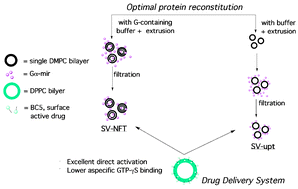Receptor-independent modulation of reconstituted Gαiprotein mediated by liposomes†
Abstract
A cationic amphiphile,

* Corresponding authors
a
Department of Chemistry and CSGI, University of Florence, Via della Lastruccia 3, Florence, Italy
E-mail:
debora.berti@unifi.it
b Department of Preclinical and Clinical Pharmacology, University of Florence, Viale Pieraccini 6, Florence, Italy
c Department of Anatomy, Histology and Forensic Medicine, Anatomy Section, University of Florence, Viale Morgagni 85, Florence, Italy
d Department of Pharmaceutical Sciences, University of Florence, Via U. Schiff 6, Florence, Italy
A cationic amphiphile,

 Please wait while we load your content...
Something went wrong. Try again?
Please wait while we load your content...
Something went wrong. Try again?
P. Luciani, D. Berti, M. Fortini, P. Baglioni, C. Ghelardini, A. Pacini, D. Manetti, F. Gualtieri, A. Bartolini and L. Di Cesare Mannelli, Mol. BioSyst., 2009, 5, 356 DOI: 10.1039/B815042G
To request permission to reproduce material from this article, please go to the Copyright Clearance Center request page.
If you are an author contributing to an RSC publication, you do not need to request permission provided correct acknowledgement is given.
If you are the author of this article, you do not need to request permission to reproduce figures and diagrams provided correct acknowledgement is given. If you want to reproduce the whole article in a third-party publication (excluding your thesis/dissertation for which permission is not required) please go to the Copyright Clearance Center request page.
Read more about how to correctly acknowledge RSC content.
 Fetching data from CrossRef.
Fetching data from CrossRef.
This may take some time to load.
Loading related content
